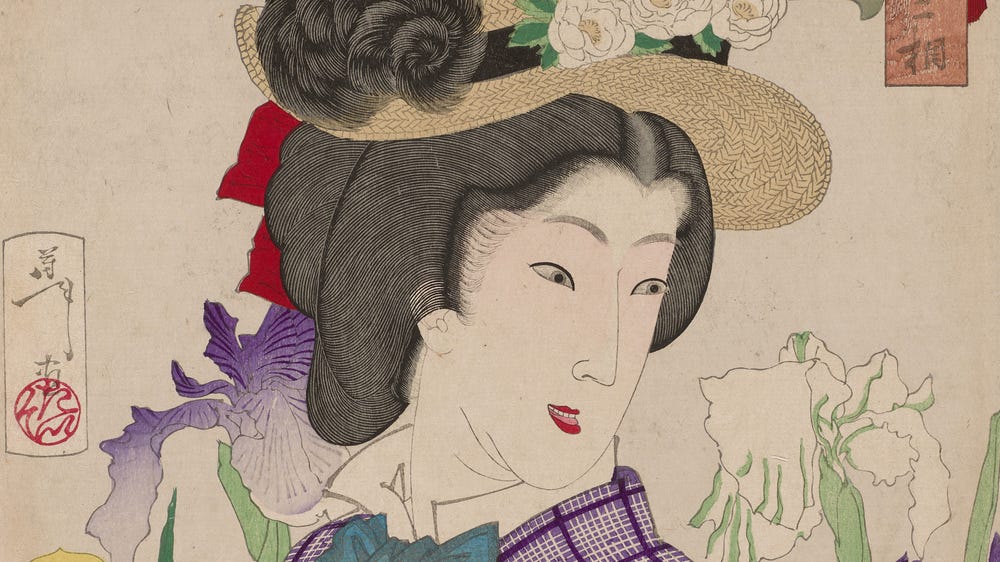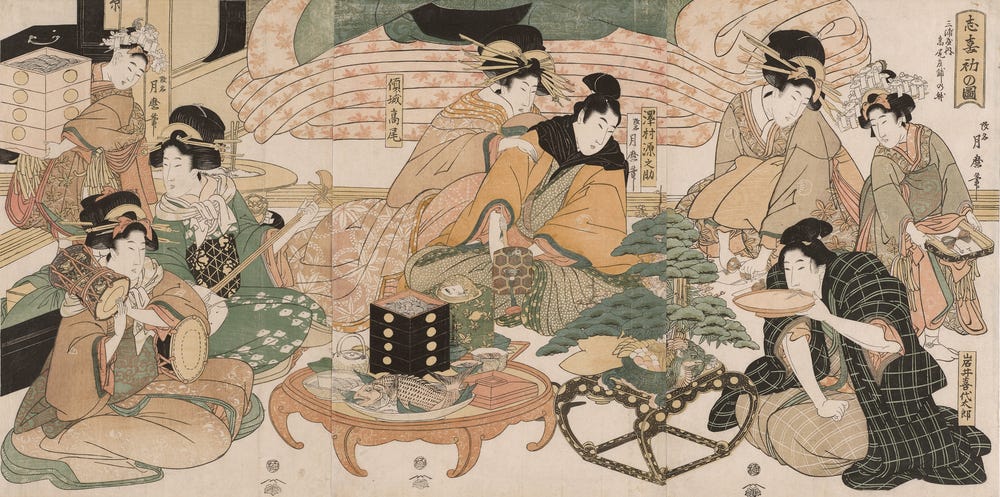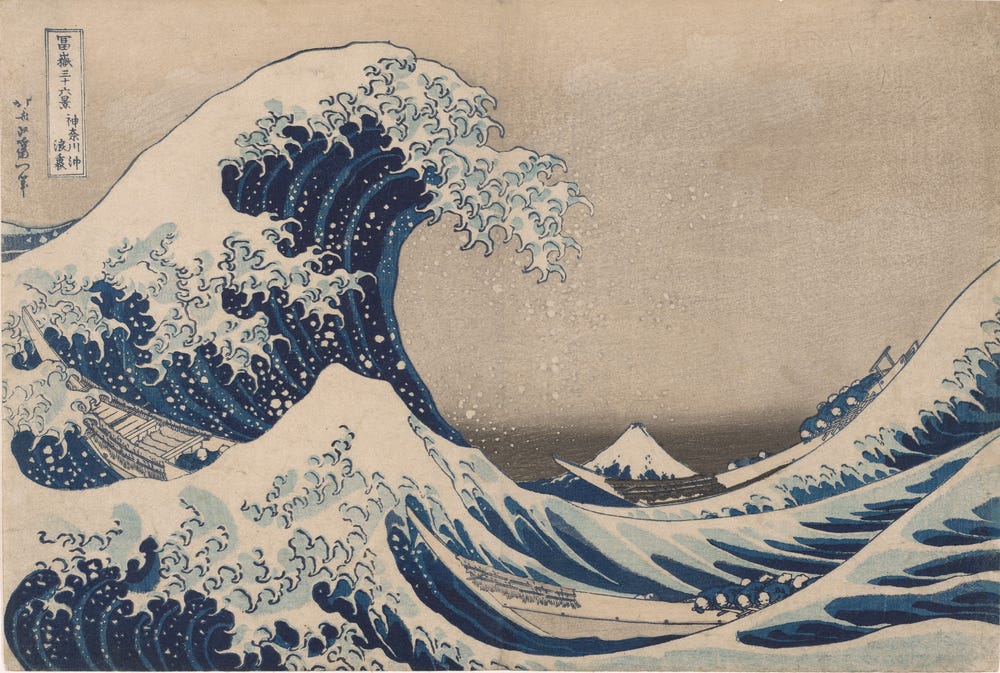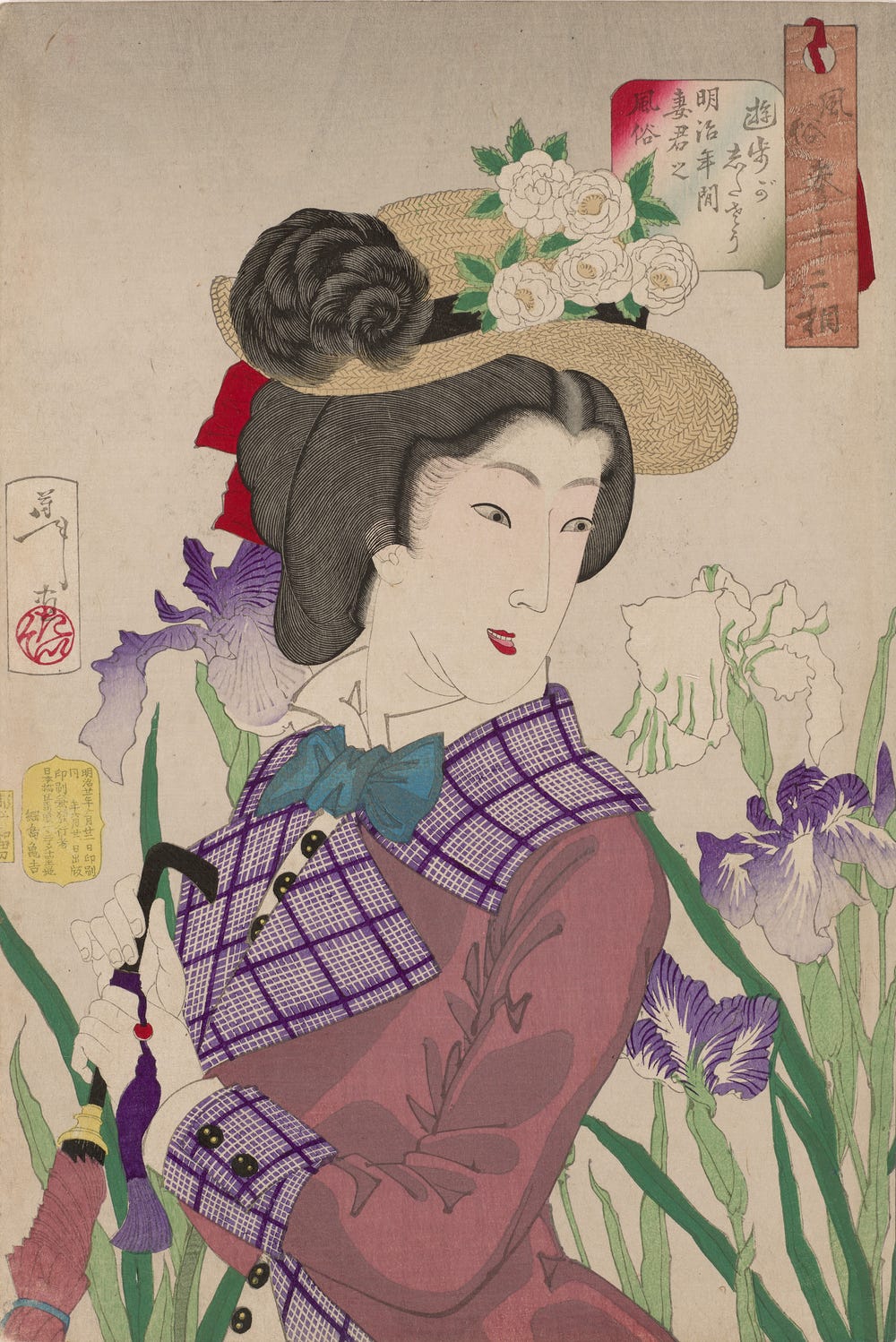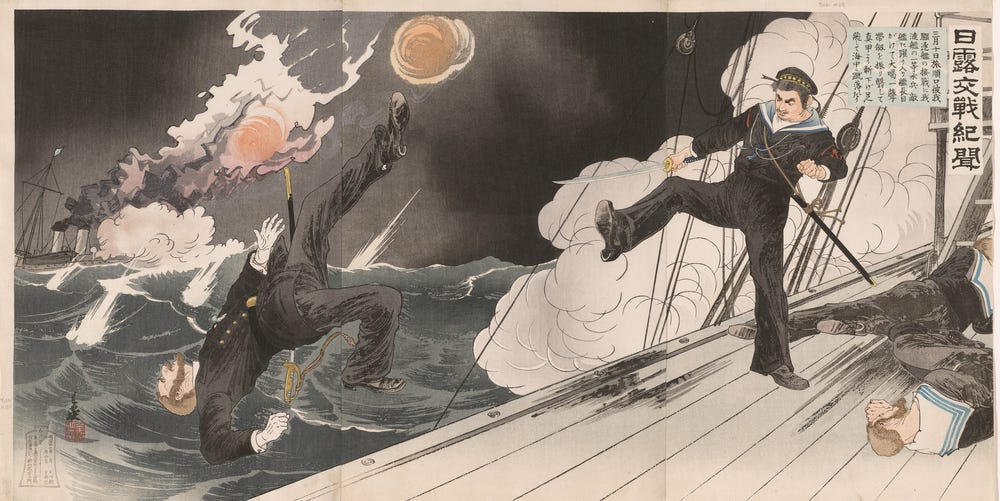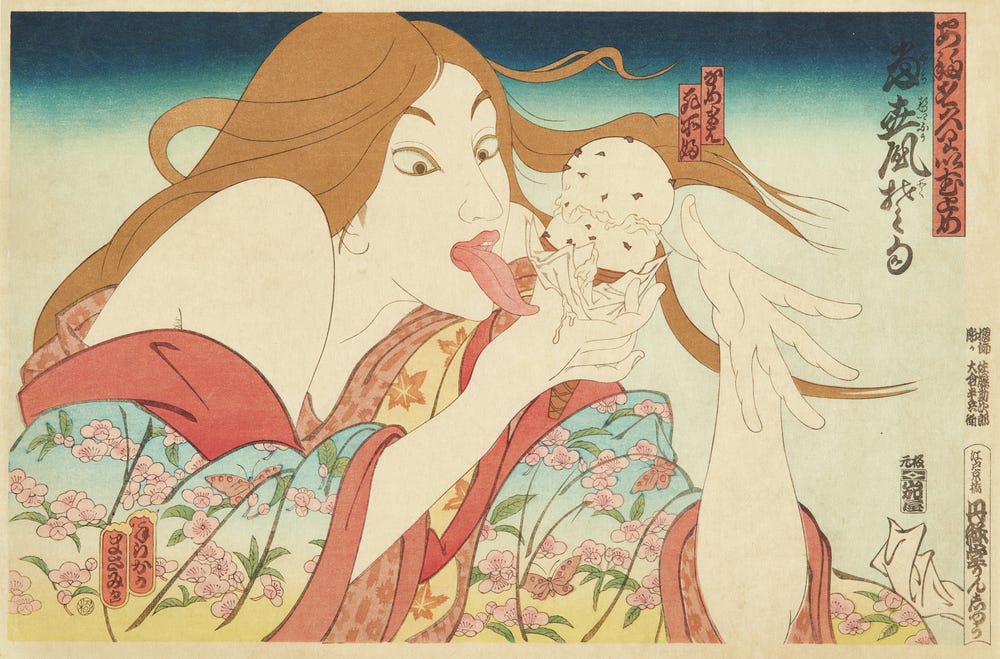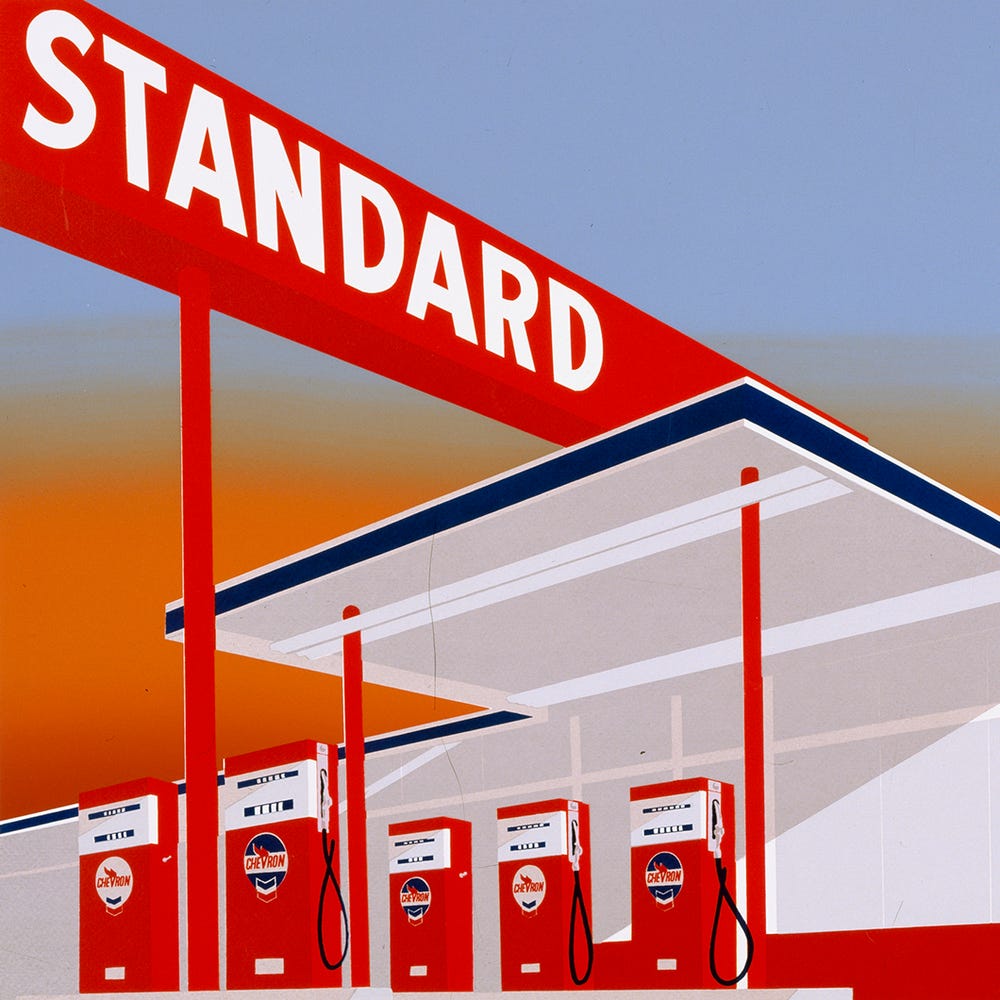Tsukioka Yoshitoshi (1839–1892). Strolling: The Appearance of an Upper-Class Wife of the Meiji Era (detail), from the series Thirty-Two Customs and Manners, 1888. Color woodblock print with embossing and lacker, 14 1⁄16 × 9 7⁄16 in. (35.7 × 24 cm). Fine Arts Museums of San Francisco, Museum purchase, Achenbach Foundation for Graphic Arts Endowment Fund and gift in memory of Michael Kent Sandgren from his friends and colleagues, 1996.43. Photograph by Randy Dodson
In the Edo period (1603–1868), woodblock prints called ukiyo-e (pictures of the floating world) celebrated the pleasures of everyday life. These prints were often delicately colored images of actors, courtesans, and scenic views. But in 1868, the shogun was overthrown and the Meiji, or “enlightened,” emperor was restored to power, ending military rule. During the Meiji era (1868–1912), the government opened the country to foreign trade, promoting a new, modern Japan. As society shifted, so too did its print culture, incorporating bright synthetic pigments and depictions of Western technology and customs.
Here are five prints that trace the evolution of woodblock prints across these turbulent eras and into the modern day.
1. Beauties and Kabuki stars
Kitagawa Tsukimaro, First Play of Musical Instruments in the New Year, ca. 1805. Color woodblock print with embossing (triptych), 15 1/16 x 10 3/16 in. (38.3 x 25.8 cm). Fine Arts Museums of San Francisco, Achenbach Foundation for Graphic Arts, 1963.30.5648
During the Edo period, some of the most popular subjects for ukiyo-e were bijin (beautiful people, especially women) and Kabuki actors. This scene brings them both together, with a woman — one of eleven generations of oiran (high-ranking prostitutes) with the honorary name Takao — being visited by two famous actors, Sawamura Gennosuke (active 1791–1811, in the upper center) and Iwai Kiyotarō (active 1787–1804, at lower right). To attract a wealthy clientele, oiran were trained in the tea ceremony, music, and conversation, and dressed in luxury fashions. While some gained fame, keeping up with the latest styles meant many also ended up bankrupt.
Kabuki was originally performed by women from the lower classes, often prostitutes. Over concerns of sexual corruption, women actors were banned from the stage and replaced by adolescent boys, and then adult males. These male actors became well respected and here, are themselves visiting prostitutes.
2. Landscape
Katsushika Hokusai (1760–1849), Under the Wave off Kanagawa (The Great Wave), from the series Thirty-Six Views of Mount Fuji, ca. 1830–1832. Color woodblock print, 9 13⁄16 x 14 ½ in. (25 x 36.9 cm). Fine Arts Museums of San Francisco, Museum purchase, Achenbach Foundation for Graphic Arts Endowment Fund, 1969.32.6. Photograph by Randy Dodson
Perhaps the most famous Japanese print ever produced, Hokusai’s The Great Wave (ca. 1830–1832) is also one of the first to use techniques and materials from the West. Inspired by Dutch landscape prints, Hokusai introduced perspective through scale. The boats in the foreground are large, with a tiny Mount Fuji peeking up from behind the waves in the background. The print also uses a brand new synthetic pigment, Berlin blue. Itself inspired by Dutch art, The Great Wave went on to influence other artists, including the Impressionists and Post-Impressionists. Today, this well-loved (and often-reproduced) print continues to inspire art lovers around the globe.
3. Western ways
Tsukioka Yoshitoshi (1839–1892). Strolling: The Appearance of an Upper-Class Wife of the Meiji Era, from the series Thirty-Two Customs and Manners, 1888. Color woodblock print with embossing and lacker, 14 1⁄16 × 9 7⁄16 in. (35.7 × 24 cm). Fine Arts Museums of San Francisco, Museum purchase, Achenbach Foundation for Graphic Arts Endowment Fund and gift in memory of Michael Kent Sandgren from his friends and colleagues, 1996.43. Photograph by Randy Dodson
A beautiful woman in a field of irises glances over her shoulder. In contrast to earlier beauties, this woman is wearing a straw hat, bright-blue bow tie, and Western-style dress. During the Meiji era, Western fashions and customs were adopted by the emperor, and prints of the emperor and his family were used to spread these customs across the nation. The empress, depicted in the latest Victorian fashions, became a symbol of modern womanhood and style, an influencer of her time.
Tsukioka Yoshitoshi (1839–1892) was one of the only artists to successfully transition from the floating world printmaking of the Edo period to the modern style of the Meiji era. This image of an upper-class woman is the last in his series Thirty-Two Customs and Manners, which traced the evolution of women in Japanese society over the previous century.
4. War and propaganda
Migita Toshihide, A Japanese Sailor Leaps on Board a Russian Warship and Kicks its Captain Overboard from Records of the Russo Japanese War, 19th-20th century, Color woodblock print with burnishing and embossing (triptych). Fine Arts Museums of San Francisco, Achenbach Foundation for Graphic Arts, 1963.30.5662. Photograph by Randy Dodson
Here, a Japanese sailor kicks a Russian captain off his own ship, as detailed in the print’s very descriptive title: A Japanese Sailor Leaps on Board a Russian Warship and Kicks its Captain Overboard. In the late 19th century, prints featuring feats of war surged in popularity. Japan was becoming a global imperial power. The nation won two major wars: the Sino-Japanese War of 1894–1895 and the Russo-Japanese War of 1904–1905. Prints like this one were used as propaganda, showing Japan’s superiority and might. Other prints from this time depicted the Japanese military as chivalrous and humane, in contrast to stereotypical depictions of the Russians and Chinese.
5. Pop culture
Masami Teraoka (American, b. Japan 1936), Today’s Special, from the series 31 Flavors Invading Japan, 1977. Color woodblock print, 10 3/8 × 15 3/4 in. (26.4 × 40 cm). Fine Arts Museums of San Francisco, Gift of Edward Den Lau, 1996.92.3. © Masami Teraoka. Courtesy of Catharine Clark Gallery and the artist. Photograph by Randy Dodson
A fast-food fantasy, contemporary artist Masami Teraoka’s Today’s Special (1977) looks back to the floating world prints of the Edo period. A beautiful young woman ravenously licks a double scoop of chocolate chip ice cream, her kimono suggestively slipping off her shoulders. A discarded napkin nods to the convention of crumpled paper as innuendo. Teraoka adopts the ukiyo-e style to comment on contemporary social issues, such as globalization and the HIV/AIDs epidemic. Here, he uses humor to critique the rising popularity of fast food in Japan.
